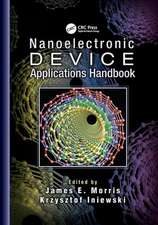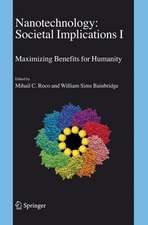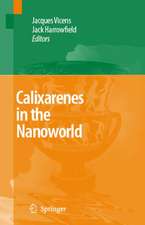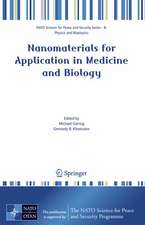Nanotechnologies in the Conservation of Cultural Heritage: A compendium of materials and techniques
Autor Piero Baglioni, David Chelazzi, Rodorico Giorgien Limba Engleză Paperback – 23 aug 2016
Main audience: Expert conservators, restorers and technical staff at conservation institutes and museums, students at conservation and restoration schools, and scientists who are new to the field of conservation of artistic and historical artifacts.
| Toate formatele și edițiile | Preț | Express |
|---|---|---|
| Paperback (1) | 569.03 lei 38-44 zile | |
| SPRINGER NETHERLANDS – 23 aug 2016 | 569.03 lei 38-44 zile | |
| Hardback (1) | 690.59 lei 6-8 săpt. | |
| SPRINGER NETHERLANDS – 4 dec 2014 | 690.59 lei 6-8 săpt. |
Preț: 569.03 lei
Preț vechi: 748.72 lei
-24% Nou
Puncte Express: 854
Preț estimativ în valută:
108.90€ • 118.25$ • 91.47£
108.90€ • 118.25$ • 91.47£
Carte tipărită la comandă
Livrare economică 18-24 aprilie
Preluare comenzi: 021 569.72.76
Specificații
ISBN-13: 9789402407044
ISBN-10: 9402407049
Pagini: 144
Ilustrații: X, 144 p. 57 illus., 21 illus. in color.
Dimensiuni: 155 x 235 x 14 mm
Greutate: 0.18 kg
Ediția:Softcover reprint of the original 1st ed. 2015
Editura: SPRINGER NETHERLANDS
Colecția Springer
Locul publicării:Dordrecht, Netherlands
ISBN-10: 9402407049
Pagini: 144
Ilustrații: X, 144 p. 57 illus., 21 illus. in color.
Dimensiuni: 155 x 235 x 14 mm
Greutate: 0.18 kg
Ediția:Softcover reprint of the original 1st ed. 2015
Editura: SPRINGER NETHERLANDS
Colecția Springer
Locul publicării:Dordrecht, Netherlands
Cuprins
Preface.- About the Authors.- Innovative Nanomaterials: Principles, Availability and Scopes.- Consolidation of Wall Paintings and Stones.- Cleaning of Wall Paintings and Stones.- Cleaning of Easel Paintings.- Deacidification of Paper, Canvas and Wood.
Notă biografică
Piero Baglioni is a full professor of Physical Chemistry and lecturer of Physical Chemistry at the Department of Chemistry of the University of Florence. He is the Director of the Center for Colloid and Surface Science (Consorzio Interuniversitario per lo Sviluppo dei Sistemi a Grande Interfase - CSGI); he is in the Advisory Board of several international journals, International organizations, and member of several national and international institutions, industries, and learned societies (e.g the European Academy of Science; the Royal Academy of Art and Science in Göteborg, Sweden; the American Chemical Society; the European Colloids and Interface Society; the European Society for Neutron Spectroscopy; Accademia delle Arti del Disegno - the oldest Academy in Italy). Piero Baglioni is author of about 400 publications on books and journals and 26 patents (5 of which in connection with art restoration). He was recipient of international prizes for his contribution to Conservation of Cultural Heritage and to the synthesis of nucleolipids, such as Lifetime achievements for the contribution to Colloids and Interface Science (JCIS), the Caballero Aguila (The most prestigious recognition from National agency for conservation in Mexico), the Gran Prix for Innovation Award and from the European Colloids and Interface Society (ECIS). The methods for the conservation of artistic and historical objects introduced by his group have been widely acknowledged.
David Chelazzi received his Master’s degree in Chemistry at the University of Florence in 2003, with a thesis work developed at the European Laboratory for Non-Linear Spectroscopy (L.E.N.S.). In 2007 he received his PhD on Science for Cultural Heritage Conservation at CSGI, on the development of physico-chemical methodologies for the conservation of paper and wood works of art. Post-doc experience included a scholarship at the “Centre de Restauration des Musées de France” (C2RMF) in Paris (Palais du Louvre), on the aging and removal of adhesives used for the lining of paintings.
As of 2010 he is a Research Fellow at CSGI - Department of Chemistry of the University of Florence, his research work focuses on the development of nanomaterials for the conservation and preservation of movable and immovable works of art. He is the author of 30 publications in the field of conservation of cultural heritage materials.
Rodorico Giorgi received his degree in Chemistry (physical-chemistry curriculum) in 1996, at the University of Florence, and in 2000 his PhD in Science for the Conservation of Cultural Heritage at the same University, with Prof. Piero Baglioni as Advisor. He is currently research fellow at the Department of Chemistry of the University of Florence and CSGI, national Center for Colloid and Surface Science. Giorgi's main research interests are in physico-chemical characterization of materials, investigation of degradation processes and development of nanotechnology for the conservation of different works of art materials, such as wall and canvas paintings, stone, paper, parchment, and archaeological wood. Giorgi is author of about 100 publications in the field of nanoscience application to cultural heritage conservation.
David Chelazzi received his Master’s degree in Chemistry at the University of Florence in 2003, with a thesis work developed at the European Laboratory for Non-Linear Spectroscopy (L.E.N.S.). In 2007 he received his PhD on Science for Cultural Heritage Conservation at CSGI, on the development of physico-chemical methodologies for the conservation of paper and wood works of art. Post-doc experience included a scholarship at the “Centre de Restauration des Musées de France” (C2RMF) in Paris (Palais du Louvre), on the aging and removal of adhesives used for the lining of paintings.
As of 2010 he is a Research Fellow at CSGI - Department of Chemistry of the University of Florence, his research work focuses on the development of nanomaterials for the conservation and preservation of movable and immovable works of art. He is the author of 30 publications in the field of conservation of cultural heritage materials.
Rodorico Giorgi received his degree in Chemistry (physical-chemistry curriculum) in 1996, at the University of Florence, and in 2000 his PhD in Science for the Conservation of Cultural Heritage at the same University, with Prof. Piero Baglioni as Advisor. He is currently research fellow at the Department of Chemistry of the University of Florence and CSGI, national Center for Colloid and Surface Science. Giorgi's main research interests are in physico-chemical characterization of materials, investigation of degradation processes and development of nanotechnology for the conservation of different works of art materials, such as wall and canvas paintings, stone, paper, parchment, and archaeological wood. Giorgi is author of about 100 publications in the field of nanoscience application to cultural heritage conservation.
Textul de pe ultima copertă
This book presents novel applications of nanotechnology for the preservation of artistic and historical artifacts. It explains the scientific principles behind numerous nanomaterials and discusses their applications to different types of common movable and fixed artistic substrates. It starts with an overview of the nano-tools developed over the last three decades, such as dispersions of nanoparticles, micellar solutions, microemulsions and gels. Compared to traditional methods, these new tools have the benefit of considerably less impact on both the operators and the environment. Each chapter is dedicated to a specific type of cultural heritage material (wall and easel paintings, stone, paper, canvas and wood) starting with the main degradation paths and discussing protocols for the application of innovative nanomaterials-based tools for cleaning, consolidation, or deacidification, which represent the majority of the case studies encountered in restoration facilities, workshops andateliers. The book provides step-by-step descriptions that are meant to support conservators in the application of these novel materials and methods. The aim of the book is to equip end-users and conservators with essential information and knowledge on the availability and applicability of different nano-materials and dispersed systems. While the book’s focus is on the practical aspects, interested readers will also find references to the relevant advanced colloid and material science literature.
Main audience: Expert conservators, restorers and technical staff at conservation institutes and museums, students at conservation and restoration schools, and scientists who are new to the field of conservation of artistic and historical artifacts.
Main audience: Expert conservators, restorers and technical staff at conservation institutes and museums, students at conservation and restoration schools, and scientists who are new to the field of conservation of artistic and historical artifacts.
Caracteristici
First book on the applications of nano technologies to conservation of cultural heritage materials Offers conservators a practical guide to get updated with the latest techniques Benefits from a close cooperation between scientists and conservators Includes supplementary material: sn.pub/extras


















